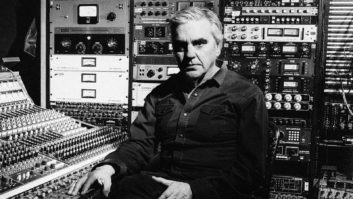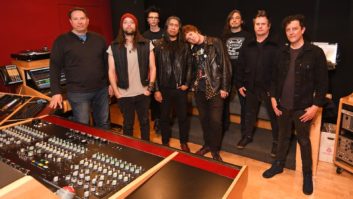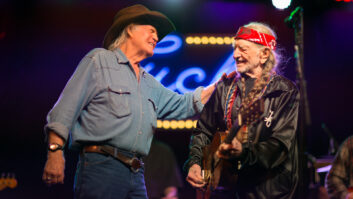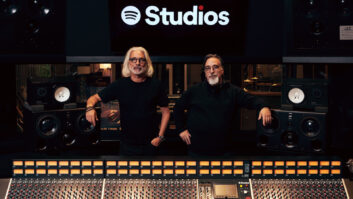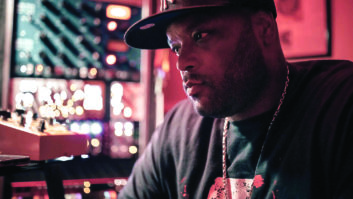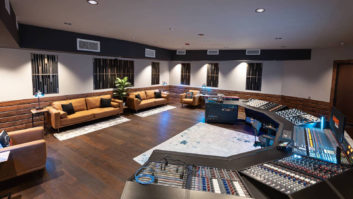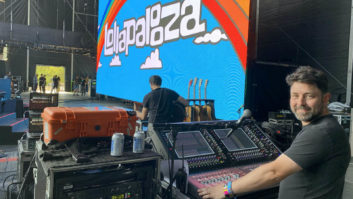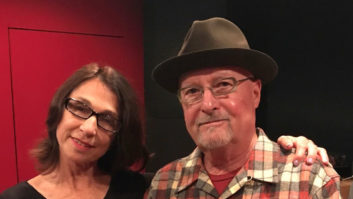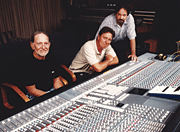

In Austin, aka Live Music Central, bands crank out power chords and acoustic ballads at all hours on nearly every street corner. But in addition to the overwhelming amount of public performances, one can also find a mixed bag of local artists and out-of-towners privately recording in one of the city’s many recording studios.
From left: Willie Nelson, Freddy Fletcher and engineer Larry Greenhill at Pedernales’ 48-channel SSL G+.
Austin’s recording community is rooted in tradition while neighboring some of the industry’s latest technology. In fact, some studios look the same as they did 20 years ago, complete with often-used analog tape machines, vintage tube gear and cavernous live rooms. These aren’t the ultrahigh-tech, streamlined designs of L.A., New York City or Miami studios, but comfortable spaces that accommodate a large pool of amazingly talented producers, engineers and musicians. Like most markets, Austin has said goodbye to a few longstanding facilites (Hit Shack, Brooklyn Bridge), but now, the recording community seems to be holding steady, with no major leaps forward, but no extreme slippage either.
At the same time, Austin-based companies such as AMD, Dell Computers, Texas Instruments and Open Labs manufacture products that support music production. Due to these companies’ close proximity and the changing industry as a whole, Austin has entered and adapted to the digital domain, despite a bit of kicking and screaming. Producer, songwriter and Asleep at the Wheel frontman Ray Benson’s 14-year-old Bismeaux Studios served as a beta test site for AMD, Steinberg and others years before his city earned the nickname “Silicon Hills.” “We are always looking for the cutting edge of digital technology and marrying it with our old, cool, wonderful-sounding tube and transistor technology,” says Benson.
High-tech or lo-fi, “There’s a place [in Austin] that can meet your budget and your technical needs,” says Wendy Morgan, executive director of the Recording Academy’s Texas chapter. “There’s just a high concentration of all the things that make a good recording environment.” Like its cool, laid-back vibe and good food. “People come here for the barbecue and the Mexican food, but also for the incredible music scene,” adds Benson. “This has always been a town of individualists and iconoclasts. We all sort of did our own thing. We compete, but we’re very friendly [with each other].”
What’s most impressive about Arlyn is its whopping 6,600 square feet of available recording space.

One of the oldest and most widely known Austin facilities resides in the suburban Briarcliff community. Willie Nelson opened Pedernales, which once housed a country club, in 1973 so that he could have a place to live, record and throw a big Fourth of July picnic. With the help of Nashville producer Chips Moman, Nelson converted the resort’s old clubhouse/restaurant into a private recording studio and made the wise decision to keep the nine-hole golf course and Olympic-size swimming pool.
“It was initially for him and his friends,” says Nelson’s nephew, Freddy Fletcher, who runs Pedernales and owns Arlyn Studio in downtown Austin. Of course, Nelson has some pretty cool friends, such as Neil Young, Merle Haggard, Kris Kristofferson and Waylon Jennings — all Pedernales clients. When the studio became a public facility in 1992 — a few years after the IRS temporarily seized it to pay off the artist’s tax debt — clients such as Barenaked Ladies, Bonnie Raitt, Joe Ely, Kenny Wayne Shepherd and Pat Green have sprawled out in the 3,000-square-foot tracking room and four iso booths. The control room features custom monitors from Steven Durr and an SSL 4048 G+ with Total Recall, interfaced with a 24-input 80 Series Neve; plenty of UREI LA-4s, dbx 160s and the like; and an abundance of tube mics, guitar amps and bass cabinets. Clients can record to Studer A800 24-track, Otari RADAR or go straight to the 48-channel Nuendo 2 system.
The other half of the Arlyn/Pedernales family is located in the old Austin Opera House, once a popular live spot that was owned by Nelson until the early ’90s. The club no longer exists, but the studio has remained intact ever since Fletcher built it in 1984. The Steven Durr — designed 22×24 control room contains a vintage API console with Uptown Moving Faders Automation, custom monitors, classic outboard gear, and Pro Tools, RADAR and Nuendo options. Studio B, suitable for voice-overs, overdubs and multimedia projects, features a Yamaha 02R and Pro Tools Mix|Plus, while Studio C is equipped for 5.1 mixing and includes a Focusrite Control|24, another Pro Tools system, a video screen and other items for ADR/looping, and sound effects and Foley recording.
To the disappointment of clients such as Robert Earl Keen and Los Lonely Boys, the room has been practically booked solid for the past year-and-a-half by one client: Mediatech Institute, a recording arts school with facilities in Houston, Dallas and Austin. “It’s been difficult,” Fletcher says of turning away bands, “but it’s hard to turn that [Mediatech business] down. But I’m really proud of the school. They’re teaching kids how to make music and do other things with audio: film, music theory, music business.”
Stuart Sullivan tweaks a mix at Wire, which offers an API 32x12x32 console with Uptown Moving Faders automation, Pro Tools|HD3 Accel and numerous outboard boxes, mics and instruments, all tied to a 16×27-foot main room with four iso booths.

In 2001 — when the dotcom industry, music sales and the stock market plummeted — a couple of years before Mediatech snatched up Arlyn, Brooklyn Bridge moved to — of all places — Brooklyn, N.Y., the popular Hit Shack closed “for reorganization” and one of Arlyn’s main engineers, Stuart Sullivan, opened Wire Recording, a one-room facility not far from his previous home. It would seem that it was the worst time to open a new business, much less a recording studio, but Sullivan has reportedly prospered, partially due to his longstanding reputation.
“I had been working out of these places for more than 15 years and had a large client base,” he says, naming such acts as Keen, Butthole Surfers’ Gibby Haynes, Patty Griffin and James McMurtrey, among others. “I borrowed in every direction I could and it’s paid off. The first year was fantastic, the last couple of years I got myself out of debt and now I’m preparing to move to the next level. There’s been a distinct increase in outside engineers coming in, which says that people have accepted what I’ve been able to put together.”
Wire attracts a “mixed bag” of local indies and national label acts. Sullivan has also noticed musicians from various U.S. locales convening to record at one central studio. “I just did a session last week where the drummer’s from L.A., the guitar player is from Dallas, the bass player is from Houston and the artist and I live in Austin,” he says. “It seems like the work has stretched to the point where you’re putting together teams and those team members can be from anywhere and come together for a record. You’re looking for a diverse group of people who have their fingers in various pies and when you bring them together, you have a more expanded base.”
Congress House’s control room features an Amek console, Pro Tools|HD Accel, Otari 2-inch and three recording spaces.

Bismeaux Studios lies “within spittin’ distance” of Wire and Arlyn, and features yet another vintage API, this one originating from Nashville’s historic RCA Studio C. In addition to a 10-foot putting green, the vast control room contains its fair share of old compressors, tube mics and pre’s (Bismeaux even makes its own tube preamp/DI boxes), but they’re far from lo-fi. Bismeaux has partnered with AMD and uses its 64-bit dual-processing system with Nuendo and Mackie Soundscape platforms. “Early on, we got involved with the high-tech community to see what products were in development and applicable to audio,” says Benson.
In that vein, the studio just completed its second room, “Bismeaux Audio Lab,” a DAW engineering school operated by ProMedia Training. Studio B features a Yamaha 02R and six 8-channel 01X boards, and HP laptops for seminar students. They’ve also installed a Polycom A/V conferencing device, which will allow them to hold master classes in engineering and virtual A/V collaboration. In addition to 10-day Pro Tools seminars, Benson plans to hold future workshops in Cubase, Nuendo, Cakewalk and other platforms compatible with AMD’s Opteron 64-bit chip.
Like Benson, Gina Fant-Saez defies Austin’s perceived “old-school” mentality; she moved to Austin from New York in 1997 with a 48-track Pro Tools rig (one of the first in the city) and an SSL 4000 G+ to open Blue World Music. During the past eight years, she’s recorded and mixed projects for locals such as Shawn Colvin and Jimmie Vaughan, but admits that most of her work has come from Nashville, L.A. and New York (U2, Chris Vrenna, Nelly Furtado). She recently sold her SSL and 2-inch Studer machine, purchased a Dangerous Music system and poured the remaining funds into her new venture, eSession.com.
Fant-Saez describes eSession as a “Web-based global virtual studio with a database of the world’s best session players.” eSession handles all file transfers and financial details of an “e-session,” with players booked from their exclusive database of top-notch players. “I just don’t see the future in large recording studios,” she says. “I see the Internet and home studios as the future.”
Austin, like many other music towns, has no shortage of home and project studios. Mike Vasquez built Sweatbox into an indie and garage rock haven. Punk bands often pop over to Bubble; the band Spoon and producer Brian Beattie work out of their pro-quality studios; and other local producers such as Stephen Bruton, Gurf Morlix, Craig Ross and Tim Kerr work at both commercial and private facilities.
Producer/engineer Mark Hallman converted one South Austin house into the vibe-y Congress House, but it is actually a dedicated commercial facility (with guest quarters) used for his projects and outside clients. Hallman rented the house in the mid-’80s as a pre-production site, and it has since grown to become his dedicated spot for producing albums for Eliza Gilkyson and Tom Russell, and engineering projects for Ani DiFranco, David Byrne, Shawn Colvin, Juliana Hatfield, Pat Green, Nanci Griffith, Junior Brown and others.
In addition to towers of outboard gear, an Amek Neve 40×32, Pro Tools HD|2 Accel (32×40 I/O), Genelec 5.1 monitoring system and a complete video editing suite reside at Treefort Studios.

Cedar Creek looks like an old cabin, but at nearly 30 years young, it is one of the city’s most beloved facilities, with clients such as Dixie Chick producer Lloyd Maines, Scott Litt, Dave McNair and others renting out the 1973 custom 32-input Neve fitted with A/D system Optifile and 3-D Automation, Studer 24-track, AMD-powered Nuendo 24/96 digital workstation and new Hear Technologies Hearback personal headphone mixing system.
There are home studios, and then there are
home
studios. Nestled high in the hills on a private, seven-acre compound lies Treefort Studios, a sunny, sprawling space with possibly the largest inventory of tube mics, preamps and other outboard gear in the big state of Texas. Owner Jack Rock, a retired corporate technology VP for Austin-based aerospace corporation Tracor Inc., marries his classic gear with a 30×20×12 tracking room, which ties to three iso rooms and a separate 20×16×16 iso
building
with video links. Amenities include a three-story guesthouse with kitchen, pool, decks, patios and frequent barbecues.
Rock, who also owns indie label Viewpoint Records, is one of those rare birds that doesn’t worry much about the state of the economy or the decline in studio business. He owns all of his property outright, and clients such as And You Will Know Us By the Trail of Dead, Spoon and Fastball seem to discover the place through word of mouth or via an invitation by Rock. He’s certainly an exception more than the rule, as most Austin studio owners are just doing the best to keep the lights on.
The Austin studio scene’s VU meter hovers at a moderate level these days, but whether it swings to a more extreme high or low depends not only on the state of the music industry, but the studios themselves. “What I have always found disconcerting about Austin is its inflexibility to embrace commercial music,” says Fant-Saez. “The music as a whole is very lo-fi roots, punk and blues. Most Austin records will simply not sell enough albums to push the city into a real professional music town. Austin music can simply not afford a world-class studio. With that said, I love Austin. It’s a great place to write music and live.”
“Other studios are very music-oriented — and I am too, because I’m a musician, for crying out loud — but I also have to be a businessman, and knowing cutting-edge technology and applying them to things that will help us stay in business is what it’s about,” adds Benson. “I want to make the most beautiful-sounding records for myself and other artists, and I have to know the technology to get that done.”
Assistant editor Heather Johnson worked at Woodland Studios in Nashville from 1995 to 1997, which once housed the API console now at Bismeaux. Small world
.

Austin boasts a wealth of recording and mastering studios
of all shapes and sizes.
for a complete listing, courtesy of the Texas Music Office.
The Texas Chapter of the Recording Academy,
which is based in Austin and serves Texas, Oklahoma and New Mexico, celebrated its 10th anniversary last year.
.
to view Pedernales’ equipment list.
to check out Wire Recording’s latest gear list.
Gina Fant-Saez spoke at length with O’Reilly Media about her studio,
Blue World Music,
and the launch of her new venture,
eSessions.com.
to read the article.
